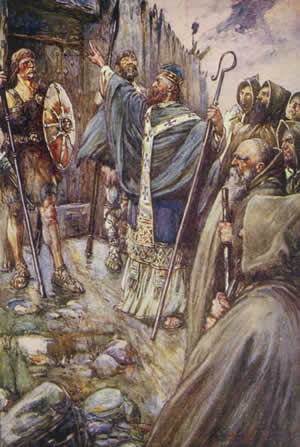Related Research Articles

Columba or Colmcille was an Irish abbot and missionary evangelist credited with spreading Christianity in what is today Scotland at the start of the Hiberno-Scottish mission. He founded the important abbey on Iona, which became a dominant religious and political institution in the region for centuries. He is the patron saint of Derry. He was highly regarded by both the Gaels of Dál Riata and the Picts, and is remembered today as a Catholic saint and one of the Twelve Apostles of Ireland.
The Culdees were members of ascetic Christian monastic and eremitical communities of Ireland, Scotland, Wales and England in the Middle Ages. Appearing first in Ireland and then in Scotland, subsequently attached to cathedral or collegiate churches; they lived in monastic fashion though not taking monastic vows.

The Cathach of St. Columba, known as the Cathach, is a late 6th century Insular psalter. It is the oldest surviving manuscript in Ireland, and the second oldest Latin psalter in the world. Its cumdach dates to the late 11th century, and was refurbished in the 14th and 16th centuries. The shrine belonged to the Chiefs of Clan Ó Domhnaill, the Lords of Tír Chonaill, as a rallying cry and protector in battle.
Lebor na hUidre or the Book of the Dun Cow is an Irish vellum manuscript dating to the 12th century. It is the oldest extant manuscript in Irish. It is held in the Royal Irish Academy and is badly damaged: only 67 leaves remain and many of the texts are incomplete. It is named after an anachronistic legend that it was made from the hide of a dun cow by Saint Ciarán of Clonmacnoise.

Diarmait mac Cerbaill was King of Tara or High King of Ireland. According to traditions, he was the last High King to follow the pagan rituals of inauguration, the ban-feis or marriage to goddess of the land. The last High King to observe the ancient pagan Feis Temrach or Assembly of Tara which took place on Samhain every three years to pass or renew laws, approve annals and records.
Brehon is a term for a historical arbitration, mediative and judicial role in Gaelic culture. Brehons were part of the system of Early Irish law, which was also simply called "Brehon law". Brehons were judges, close in importance to the chiefs.

Finnian of Movilla was an Irish Christian missionary. His feast day is 10 September.
Áed mac Ainmuirech was High King of the Northern Uí Néill. He belonged to the Cenél Conaill and was a distant cousin of Columba of Iona. He was the son of Ainmuire mac Sétnai, a previous possible high king. His mother was Bríg, daughter of Chobtaig, son of Ailill, son of Nath Í, son of Crimthann mac Énnai son of Énnae Cennsalach of the Uí Ceinnselaig dynasty from Leinster. He was born in 530 according to the Annals of Tigernach (596.2).
Áed Dub mac Suibni was an Irish king of the Dál nAraidi in the over-kingdom of Ulaid. He may have been king of the Ulaid. Áed was succeeded by his great-nephew Fiachnae mac Báetáin.
Áed mac Diarmato, called Áed Sláine, was the son of Diarmait mac Cerbaill. Legendary stories exist of Áed's birth. Saint Columba is said to have prophesied his death. His descendants, the Síl nÁedo Sláine—the seed of Áed of Slane—were prominent in 7th and early 8th century Ireland.
Ainmuire mac Sétnai or Ainmire or Ainmere was a High King of Ireland from the Cenél Conaill branch of the Uí Néill. He was the great-grandson of Conall Gulban, founder of this branch. He ruled from 566 to 569. He was the first high king from the Cenél Conaill.
Áed mac Echach Tirmcharna was a King of Connacht from the Uí Briúin branch of the Connachta. He was the son of Echu Tirmcharna mac Fergusso. He came to the throne in the year 557 and ruled until 575.
Diarmait was a son of Áed Sláine. According to the Irish annals, he was High King of Ireland.
Blathmac was a son of Áed Sláine. According to the Irish annals, he was High King of Ireland.
Forggus mac Muirchertaig, also called Forrgus mac Maic Ercae, is included in most lists of High Kings of Ireland.
Domnall mac Muirchertaig, called Domnall Ilchelgach and Domnall mac Maic Ercae, was said to be a High King of Ireland.
Events from the 7th century in Ireland.

Kells Round Tower is a round tower in Kells, County Meath in Ireland. The tower, and the high crosses nearby, are National Monuments.
Drumcliff Monastery was located in Cairbre Drom Cliabh, now County Sligo, five miles north of the modern town of Sligo. The site consists of the remains of a round tower and several high crosses, including one outstanding example. It is currently also the site of a Church of Ireland parish church and a graveyard. It is the burial place of the poet William Butler Yeats. Founded in the 6th century by Saint Colmcille, he is said to have declared in a later literary fragment:
Beloved to my heart also in the West— Drumcliffe at Culcinne's strand.
Daniel O'Donnell was a brigadier-general in the Irish Brigade in the French service. He belonged to the derbhfine of the last Chief of the Name of Clan O'Donnell and Lord of Tyrconnel.
References
- ↑ Story: St Columba and modern copyright; battle in 6th Century Ireland, Open source.
- ↑ First copyright case (PDF), Funeral, Mar 2005.
- ↑ "Cathach". Royal Irish Academy Library. 2 July 2014. Archived from the original on 2014-07-02.
- ↑ "The Cathach/The Psalter of St. Columba". Library Cathach. Royal Irish Academy. Archived from the original on 2014-07-02.
- ↑ Lacey, Brian (2003). "The Battle of Cúl Dreimne: A Reassessment". The Journal of the Royal Society of Antiquaries of Ireland. 133: 78–85. JSTOR 25509109.